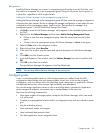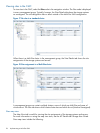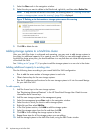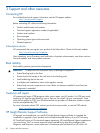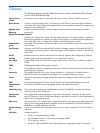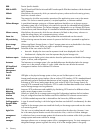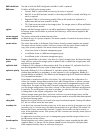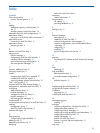MIB Management information base. A database of managed objects accessed by network management
protocols. An SNMP MIB is a set of parameters that an SNMP management station can query
or set in the SNMP agent of a network device (for example, a router).
Multi-Site cluster A cluster of storage that spans multiple sites (up to three). A Multi-Site cluster must meet at least
one of the following conditions:
• Contain storage systems that reside in two or more sites
• Contain storage systems that span subnets
• Contain multiple VIPs. The cluster can have a single site, and the multiple VIPs make it a
multi-site cluster.
network RAID Synchronous replication, mirroring or parity protection on a volume-by-volume basis. Protecting
data for a volume across all storage systems in the cluster. Network RAID-10, 10+1 or 10+2 is
required to protect data in HP StoreVirtual Storage.
network window Graphically depicts the status of each storage system. Storage systems on the network are either
available or part of a management group.
NTP Network Time Protocol
original primary
volume
The primary volume that fails and then is returned to service.
overprovisioned
cluster
An overprovisioned cluster occurs when the total provisioned space of all volumes and snapshots
is greater than the physical space available on the cluster. This can occur when there are snapshot
schedules and/or thinly provisioned volumes related to the cluster.
parity In RAID 5, redundant information is stored as parity distributed across the disks. Parity allows the
storage system to use more disk capacity for data storage.
peer site Absence of a primary site designation makes all the sites peer sites.
point-in-time
snapshot
Snapshots that are taken at a specific point in time, but an application writing to that volume may
not be quiesced. Thus, data may be in flight or cached and the actual data on the volume may
not be consistent with the application's view of the data.
preferred interface A preferred interface is the interface within an active backup bond that is used for data transfer
during normal operation.
primary site A site designation assigned by the administrator in the HP StoreVirtual Centralized Management
Console. A primary site is more important than a secondary site. In this setup, you would run a
majority of managers in the primary site. In a two-site setup, this allows the primary site to stay
online even if the network link between the primary and secondary sites fails. Typically, the
primary site has majority/all of the application servers. In configurations that do not designate
a primary site, the sites are referred to as “peer” sites.
primary snapshot A snapshot of the primary volume which is created in the process of creating a remote snapshot.
The primary snapshot is located on the same cluster as the primary volume.
primary volume The volume which is being accessed (read/write) by the application server. The primary volume
is the volume that is backed up with Remote Copy.
quorum A majority of managers required to be running and communicating with each other in order for
the LeftHand OS software to function.
RAID device RAID (originally redundant array of inexpensive disks, now redundant array of independent disks)
refers to a data storage scheme using multiple hard drives to share or replicate data among the
drives.
RAID levels Type of RAID configuration:
• RAID 0 - data striped across disk set
• RAID 1 - data mirrored from one disk onto a second disk
• RAID 10 - mirrored sets of RAID 1 disks
• RAID 5 - data blocks are distributed across all disks in a RAID set. Redundant information
is stored as parity distributed across the disks.
RAID quorum Number of intact disks required to maintain data integrity in a RAID set.
35



